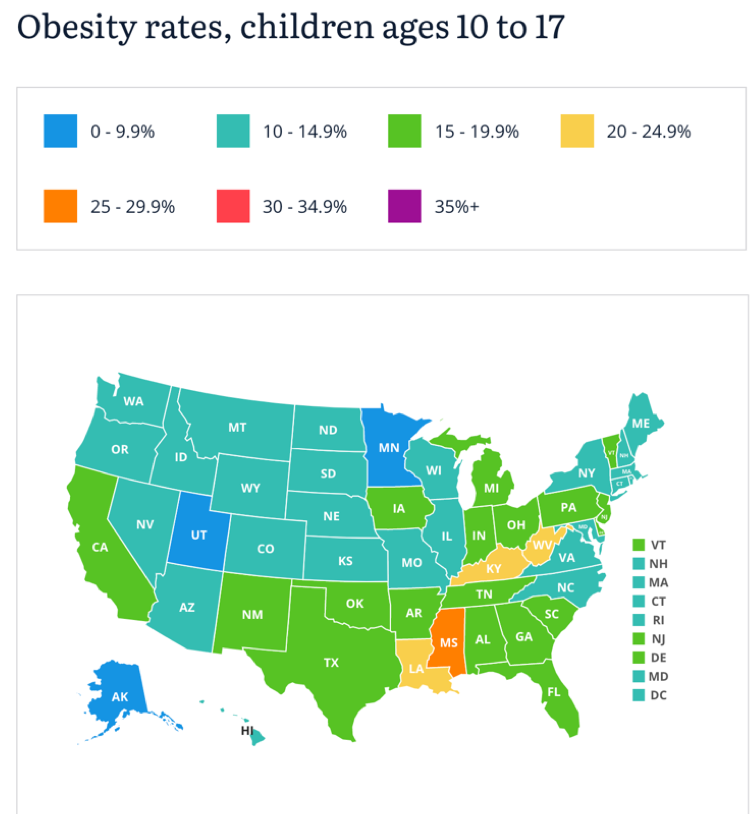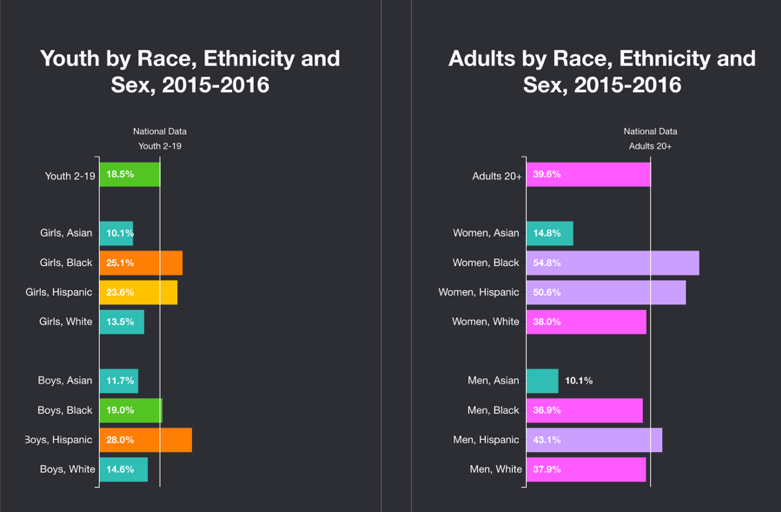Four Major Recommendations from RWJF on the State of Childhood Obesity
By Eliza Skoler
 By Ursula Biba and Eliza Skoler
By Ursula Biba and Eliza Skoler
The new State of Childhood Obesity report and website show that youth obesity is prevalent in the US, leading to high rates of adult obesity
Last week the Robert Wood Johnson Foundation (RWJF) released its State of Childhood Obesity website and report, a major update to its previous State of Obesity. It emphasizes early intervention in establishing healthy habits and preventing childhood obesity. Check out the new website here and the revised State of Childhood Obesity: Helping All Children Grow Up Healthy report with new data and recommendations here.
Childhood obesity puts children at greater risk for developing type 2 diabetes, high blood pressure, heart disease, and asthma. Given that 75%-80% of teenagers with obesity will become adults with obesity, preventing childhood obesity is an obvious priority.
The original State of Obesity report summarized child and adult data from the CDC’s Behavioral Risk Factor Surveillance System (BRFSS) and National Health and Nutrition Examination Survey (NHANES). The new report added child obesity data from the National Survey of Children’s Health, Youth Behavior Surveillance System, and WIC participants. From the data, RWJF created interactive maps and graphs; it also offered new policy recommendations to lower the rates of childhood obesity and to promote healthier families and communities.
 Here are some striking findings from the brand-new report:
Here are some striking findings from the brand-new report:
-
4.8 million kids ages 10-17 had obesity in 2017-18
-
14.8% of U.S. high school students have obesity, and an additional 15.6% are overweight
-
Childhood obesity costs $14 billion annually in direct costs in the US alone
-
Though the national obesity rate has stabilized over the past several years, childhood obesity remains at record highs in the United States, as does severe adult obesity
-
Hispanic and black youth show obesity rates of 25.8% and 22.0%, respectively, compared to the 14.1% obesity rates in white youth.

-
21.9% of children in low-income households had obesity, compared to 9.4% of children in households with higher incomes
-
Youth trends mirror adult trends, so early intervention is key to preventing obesity in all stages of life
What does RWJF recommend?
Because obesity rates were found to depend on race, ethnicity, and income, RWJF wrote policy recommendations to work toward health equity. The data shows that black and Latinx youth are at higher risk for childhood obesity than their white and Asian counterparts. In the report, RWJF writes that these trends are evidence of systemic problems due to policy, environmental, cultural, and individual causes.
Here are some recommendations:
-
More funding for the Supplemental Nutrition Assistance Program (SNAP) benefits and the SNAP-Ed nutrition education and guidance program, to allow people to afford healthy foods and make nutritious food decisions.
-
The federal government should uphold nutrition standards for school meals and snacks, and states can add additional nutrition standards.
-
Restaurants should take sugary drinks off of kids’ menus.
-
The Center for Disease Control (CDC) should support states in creating anti-obesity campaigns that address the different underlying factors that contribute to childhood obesity.
Examples of successful community programs that have slowed obesity rates can be found on the website. Recent posts include articles about a legislator making exercise more equitable in San Antonio, a pediatrician partnering with communities to address social determinants of health in Boston, and the Growing Health Kids Columbus Coalition working to promote water over sugary drinks in Ohio. These stories connect the themes discussed in the report and inspire community members to reduce the rates of childhood obesity in their neighborhoods.








